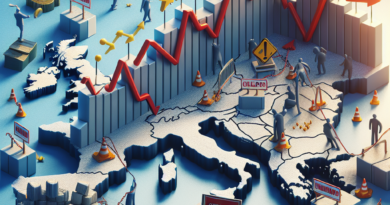Why are the markets "against" the Fed and the ECB?
Markets and central banks do not seem to agree on interest rate forecasts.
On Friday 1 December, Jerome Powell rejected Wall Street's growing expectations of rate cuts in the first half of 2024.
Even in Europe, traders continue to bet on an imminent decrease in the cost of money, bringing the possibility of a quarter point cut by March to 75% from just 10% last week.
However, despite a more accommodating tone, ECB officials remain cautious and invite investors to exercise caution when assessing inflation.
The markets, however, appear euphoric about the imminent turn towards lower interest rates which can avert recession and relaunch growth.
The disagreement between traders and central banks, however, remains and indicates that the global monetary and economic policy scenario is still full of pitfalls.
read also Inflation is slowing down more and more in Europe (and in Italy).
What will the ECB do? Fed dampens enthusiasm: no rate cut in sight The president of the Federal Reserve has rejected market expectations of next interest rate cuts, because it is still too early to declare victory over inflation.
Despite a series of positive indicators regarding prices, the central bank leader said that the Federal Open Market Committee intends to "maintain a restrictive policy" until it is truly clear and certain that inflation is returning to 2%.
“It would be premature to conclude the restrictive stance that has been achieved, or to speculate on when policy might ease,” Powell said in a speech at Spelman College in Atlanta.
“We are ready to tighten the policy further if it is appropriate to do so.” However, he also noted that policy has reached "good tightening territory" and noted that the balance of risks between doing too much or too little on inflation is now about balanced.
Precisely this more positive message was received by the markets, which increased the probability of a quarter-point cut at the March meeting of the Federal Open Market Committee to well above 50%, and fully discounted a cut in May.
Traders expect more than full cuts by December 2024.
By contrast, Fed officials have estimated rates at 5%-5.25% late next year, per their September forecast, just a quarter of a point below the level current.
read also USA, GDP jumps by 5.2% in the third quarter.
But pay attention to this data ECB cautious on rates, but stop the increases? The ECB is not ready to consider reducing funding costs now, but will look into the issue at some point during 2024: this is the latest cautious observation on monetary policy in the Eurozone, expressed by the governor of the Bank of France .
“Barring any shocks, rate hikes are now over,” Villeroy said at a conference near Paris.
“The question of cutting could arise when the time comes, in 2024, but not now: when a remedy is effective, you have to be quite patient about its duration.” The French central banker's comments come after data on Thursday showed inflation slowing faster than expected to 2.4% in November, the lowest level since mid-2021.
In the wake of this data, investors are They shrugged off hawkish politicians' comments and increased bets that a first interest rate cut will come in April.
read also Watch out for the next ECB move (not about rates) Money markets are also fully discounting an easing of 125 basis points by the end of next year, compared to just 82 basis points last week.
Villeroy said euro zone data shows the disinflation process “is even faster than expected,” particularly in the services sector, according to comments provided by the Bank of France.
“There may be a few months of lull, but this supports our forecast of inflation returning towards 2% by 2025 at the latest, barring external shocks,” he said.
Last week, ahead of November's inflation data, Villeroy said the ECB was likely to keep borrowing costs at a 4% plateau "at least for the next meetings and the next few quarters." Caution over rate cuts remains high in Frankfurt.
2024 is expected to be a more accommodative year for monetary policy, but there are too many unknowns related to global geopolitics and finance to show optimism.
As the markets, however, are doing.




